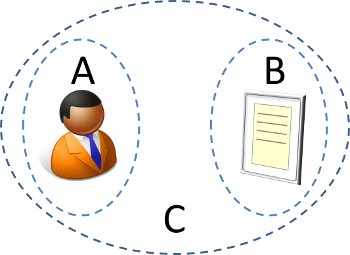Table of Contents
The Basic Techniques
Introduction
The phenomenon of emergence can be initiated and stimulated by the use of various processes. The underlying structure of some of these processes has been discussed in this and previous chapters.
In this section we will introduce the processes we will be running for elicitation of knowledge from within the clients system. This will generate knowledge/information from three points: A, B and C.
Figure 16
Searching for knowledge from within ‘C’ will usually bring new nodes into the network, i.e. another ‘B’ will be created and placed in relation to everything else.
Questions directed to ‘B’ and ‘A’ are also prone to creating new nodes as well, as a facilitator be aware of your clients language and notice when new classes/sets of information or experience emerge. These can be placed on new sheets of paper and placed in relation to everything else.
The Basic Processes of Emergent Knowledge
The Basic Ingredients
We have already met our client or the observer (A):
Figure 17
And our mission statement, problem, goal or the observed (B):
Figure 18
We will now be learning some of the more advanced Emergent Knowledge terms and processes that can be applied to the above. We will also present the ‘Basic Formula’ that can be applied immediately as a therapeutic technique.
As we discussed earlier, the space of ‘A’ holds who the client is and what they know here and now. Its separation from ‘B’ is how the space of ‘C’ comes to exist. It is proposed that the space of ‘C’ is what keeps the client at ‘A’ from resolving the problem or achieving the mission at ‘B’.
Figure 19
As the facilitator we may now ask questions of ‘A’, ‘B’ or ‘C’ in the belief that not only does the client have information about the statement, but so does the statement itself, as does the space in between.


